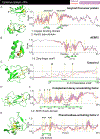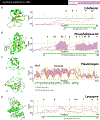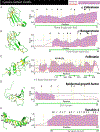Disorder and cysteines in proteins: A design for orchestration of conformational see-saw and modulatory functions
- PMID: 32828470
- PMCID: PMC8048112
- DOI: 10.1016/bs.pmbts.2020.06.001
Disorder and cysteines in proteins: A design for orchestration of conformational see-saw and modulatory functions
Abstract
Being responsible for more than 90% of cellular functions, protein molecules are workhorses in all the life forms. In order to cater for such a high demand, proteins have evolved to adopt diverse structures that allow them to perform myriad of functions. Beginning with the genetically directed amino acid sequence, the classical understanding of protein function involves adoption of hierarchically complex yet ordered structures. However, advances made over the last two decades have revealed that inasmuch as 50% of eukaryotic proteome exists as partially or fully disordered structures. Significance of such intrinsically disordered proteins (IDPs) is further realized from their ability to exhibit multifunctionality, a feature attributable to their conformational plasticity. Among the coded amino acids, cysteines are considered to be "order-promoting" due to their ability to form inter- or intramolecular disulfide bonds, which confer robust thermal stability to the protein structure in oxidizing conditions. The co-existence of order-promoting cysteines with disorder-promoting sequences seems counter-intuitive yet many proteins have evolved to contain such sequences. In this chapter, we review some of the known cysteine-containing protein domains categorized based on the number of cysteines they possess. We show that many protein domains contain disordered sequences interspersed with cysteines. We show that a positive correlation exists between the degree of cysteines and disorder within the sequences that flank them. Furthermore, based on the computational platform, IUPred2A, we show that cysteine-rich sequences display significant disorder in the reduced but not the oxidized form, increasing the potential for such sequences to function in a redox-sensitive manner. Overall, this chapter provides insights into an exquisite evolutionary design wherein disordered sequences with interspersed cysteines enable potential modulatory protein functions under stress and environmental conditions, which thus far remained largely inconspicuous.
Keywords: Cysteine-rich sequences; Cysteines; Disulfide bonds; Intrinsically disordered proteins; Intrinsically disordered regions; Metal binding; Modulatory functions; Redox sensitivity.
© 2020 Elsevier Inc. All rights reserved.
Figures





Similar articles
-
Large-Scale Analysis of Redox-Sensitive Conditionally Disordered Protein Regions Reveals Their Widespread Nature and Key Roles in High-Level Eukaryotic Processes.Proteomics. 2019 Mar;19(6):e1800070. doi: 10.1002/pmic.201800070. Epub 2019 Jan 28. Proteomics. 2019. PMID: 30628183
-
Fully reduced granulin-B is intrinsically disordered and displays concentration-dependent dynamics.Protein Eng Des Sel. 2016 May;29(5):177-86. doi: 10.1093/protein/gzw005. Epub 2016 Mar 7. Protein Eng Des Sel. 2016. PMID: 26957645 Free PMC article.
-
Disulfide bonds and disorder in granulin-3: An unusual handshake between structural stability and plasticity.Protein Sci. 2017 Sep;26(9):1759-1772. doi: 10.1002/pro.3212. Epub 2017 Jun 22. Protein Sci. 2017. PMID: 28608407 Free PMC article.
-
Proteins without unique 3D structures: biotechnological applications of intrinsically unstable/disordered proteins.Biotechnol J. 2015 Mar;10(3):356-66. doi: 10.1002/biot.201400374. Epub 2014 Oct 6. Biotechnol J. 2015. PMID: 25287424 Review.
-
Self-assembling systems comprising intrinsically disordered protein polymers like elastin-like recombinamers.J Pept Sci. 2022 Jan;28(1):e3362. doi: 10.1002/psc.3362. Epub 2021 Sep 20. J Pept Sci. 2022. PMID: 34545666 Review.
Cited by
-
Research Progress of Disulfide Bond Based Tumor Microenvironment Targeted Drug Delivery System.Int J Nanomedicine. 2024 Jul 24;19:7547-7566. doi: 10.2147/IJN.S471734. eCollection 2024. Int J Nanomedicine. 2024. PMID: 39071505 Free PMC article. Review.
-
Revealing Intrinsic Disorder and Aggregation Properties of the DPF3a Zinc Finger Protein.ACS Omega. 2021 Jul 13;6(29):18793-18801. doi: 10.1021/acsomega.1c01948. eCollection 2021 Jul 27. ACS Omega. 2021. PMID: 34337219 Free PMC article.
-
Positions of cysteine residues reveal local clusters and hidden relationships to Sequons and Transmembrane domains in Human proteins.Sci Rep. 2024 Oct 29;14(1):25886. doi: 10.1038/s41598-024-77056-8. Sci Rep. 2024. PMID: 39468182 Free PMC article.
-
Protein chains in tight-binding framework.J Mol Model. 2025 Jul 29;31(8):223. doi: 10.1007/s00894-025-06450-4. J Mol Model. 2025. PMID: 40728749
-
Quantum transport in protein chains.Sci Rep. 2025 Jul 23;15(1):26703. doi: 10.1038/s41598-025-11140-5. Sci Rep. 2025. PMID: 40695897 Free PMC article.
References
-
- Kendrew JC, Bodo G, Dintzis HM, Parrish RG, Wyckoff H, Phillips DC. A three-dimensional model of the myoglobin molecule obtained by X-ray analysis. Nature. 1958;181:662–666. - PubMed
-
- Perutz MF, Rossmann MG, Cullis AF, Muirhead H, Will G, North ACT. Structure of hæmoglobin: a three-dimensional fourier synthesis at 5.5-Å, Resolution, obtained by X-ray analysis. Nature. 1960;185:416–422. - PubMed
-
- Romero P, Obradovic Z, Kissinger CR, et al. Thousands of proteins likely to have long disordered regions. Pac Symp Biocomput. 1998;437–448. - PubMed
-
- Garner E, Cannon P, Romero P, Obradovic Z, Dunker AK. Predicting disordered regions from amino acid sequence: common themes despite differing structural characterization. Genome Inform Ser Workshop Genome Inform. 1998;9:201–213. - PubMed
-
- Dunker AK, Lawson JD, Brown CJ, et al. Intrinsically disordered protein. J Mol Graph Model. 2001;19:26–59. - PubMed
Publication types
MeSH terms
Substances
Grants and funding
LinkOut - more resources
Full Text Sources

